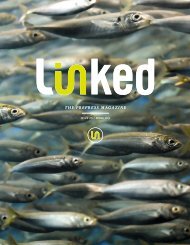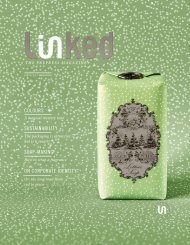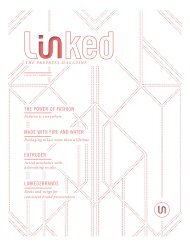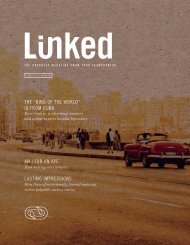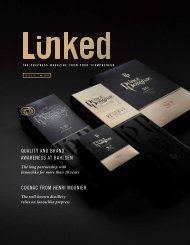Janoschka magazine Linked_V6_2021
Create successful ePaper yourself
Turn your PDF publications into a flip-book with our unique Google optimized e-Paper software.
32
f a c e t o f a c e
issue #6 ©
l i n k e d
33
“Unlike other natural fruits, such
as vanilla or bananas, there is no
specific coffee taste molecule,” Tesfaye
explains. “Instead, it is the work of
countless diligent hands, the quality
and special goodness of the raw
product and the country of origin that
give the coffee the richness that we experience
with every cup,” he continues,
summing up the long history of coffee
in a nutshell.
A matter of taste
Zeitgeist is King when it comes to preparation
Who needs a coffee molecule?
Coffee is so much more than that.
Coffee is magic...
Pour
over
Arabic
mocca
Espresso
makers
A simple way to indulge the senses: the Ethiopian coffee ceremony
Formally known as filter
coffee. As well as getting the
amount of coffee, the fineness
of the grind and the water
temperature exactly right,
a special pouring technique
is needed to allow the coffee
flavour to fully develop.
The oldest way of making
coffee uses special little jugs
made of copper or brass
with long handles (ibrik).
The classic design of the
little octagonal aluminium
pots originated with Alfonso
Bialetti in 1933.
First wave:
coffee for
everyone
Second wave:
coffee
to go
Third wave:
back to
the beans
Drinking coffee first became an established
household habit between the
1930s and 1960s.
Whereas previously coffee had been an
exclusive commodity, specially weighed
for customers in small shops and
then freshly ground, it now became a
cheaply produced industrial good that
could be bought in supermarkets ready
ground and vacuum packed.
Starting in the 1980s, high-quality
Arabicas and espresso beverages found
their way onto the mass market as “coffee
to go“. Cappuccino, latte macchiato etc.
required a lot of milk. The trend of
enhancing coffee with artificial aromas
and syrup came from the United States.
This wave was accompanied by the advent
of fully automatic coffee machines as
well as machines that used capsules
or pads for a quick cup of coffee at home
or in the office.
Here, the emphasis was on the special
qualities of coffee as well as on fair trade.
“The third wave appreciates each coffee
for what it truly is and takes whatever
steps are necessary to highlight the
amazing, unique character in every
coffee”, Nicholas Cho, Wrecking Ball
Coffee Roasters, San Francisco.
Single-origin coffees, quality criteria such
as growing region and year, plantation,
roaster and method of preparation have
an important role to play alongside
social aspects such as fair production
and trade.
Portafilter
machines
Attempts to make coffee
with machines that generate
steam go back to the nineteenth
century. This method
allows a typical Italian
espresso, with its dark oily
quality and markedly creamy
consistency, to be made in
just 25 seconds.
Aero-
Press
Water is poured onto coffee
powder and, after it has been
stirred by hand, it is pressed
down with a plunger directly
into a cup.
Cold
drip
Ice-cold water drips slowly
into a vessel containing
freshly ground coffee. After
several hours this produces
a coffee concentrate, which
can either be drunk neat
or diluted with water for a
longer drink.



